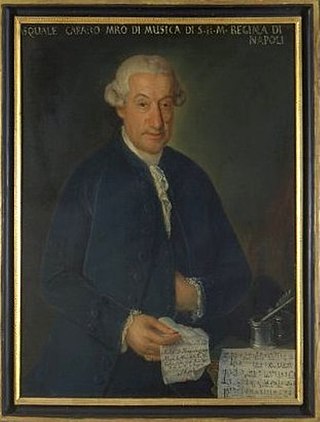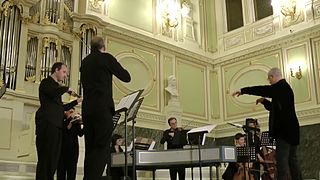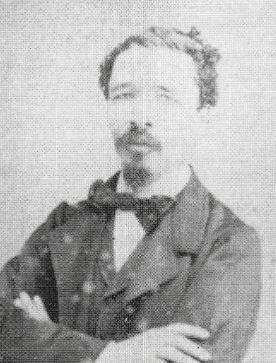| Music of Italy | ||||||||
| General topics | ||||||||
|---|---|---|---|---|---|---|---|---|
| Genres | ||||||||
| Specific forms | ||||||||
| Gregorian chant | ||||||||
| Media and performance | ||||||||
| ||||||||
| Nationalistic and patriotic songs | ||||||||
| ||||||||
| Regional music | ||||||||
| ||||||||
This is a list of music conservatories in Naples , Italy.
| Music of Italy | ||||||||
| General topics | ||||||||
|---|---|---|---|---|---|---|---|---|
| Genres | ||||||||
| Specific forms | ||||||||
| Gregorian chant | ||||||||
| Media and performance | ||||||||
| ||||||||
| Nationalistic and patriotic songs | ||||||||
| ||||||||
| Regional music | ||||||||
| ||||||||
This is a list of music conservatories in Naples , Italy.
The Naples Conservatory of Music is a music school located in Naples, Italy. It is situated in the complex of San Pietro a Majella.
It was originally located in the church of the former monastery of San Sebastiano and was called the Conservatorio di San Sebastiano, formed in 1807 by the merger of the Conservatorio di Santa Maria di Loreto, the Conservatorio di Sant' Onofrio in Capuana, and the Conservatorio della Pietà dei Turchini. It also became known as the Real Collegio di Musica, and after 1826 when it moved to its current location, as the Conservatorio di Musica San Pietro a Majella. [1] [2]

The conservatory and adjacent church are today part of the old San Pietro a Majella monastic complex, built at the end of the 13th century and dedicated to the monk Pietro da Morone, who became Pope Celestine V in 1294. The conservatory houses an impressive library of manuscripts pertaining to the lives and musical production of composers who lived and worked in Naples, among whom are Alessandro Scarlatti, Pergolesi, Vincenzo Battista, Domenico Cimarosa, Rossini, Bellini, and Donizetti. Vittorio Monti, who around 1904 composed the famous Csárdás, studied violin and composition at this conservatory. Another student was Leonardo De Lorenzo, flautist of many American orchestras and teacher at the Eastman School of Music. The historical museum has a display of rare antique musical instruments.
San Pietro a Majella is the last in a long string of establishments that have been music conservatories in Naples. Their existence goes back to the Spanish rule of the city as a vicerealm starting in the early 16th century. These early conservatories were Santa Maria di Loreto, Pietà dei Turchini, Sant'Onofrio a Capuana, and I Poveri di Gesù Cristo. They enjoyed a considerable reputation as training grounds not only for young children to be trained in church music, but, eventually, as a feeder system into the world of commercial music once that opened up in the early 17th century.
Santa Maria di Loreto was built in 1535 and was the original conservatory in Naples, coming at the beginning of the Spanish expansion of Naples under the city's most famous viceroy, don Pedro de Toledo. It is the first secular music conservatory. [3] Alumni include Salvatore Lanzetti [4] and Domenico Cimarosa. Old maps show Santa Maria di Loreto to have been a seafront "borgo" —a separate section of town. Thus, the conservatory was beyond the Spanish fortifications that guarded the southeastern approach to Naples.
Sant'Onofrio a Capuana dates from 1578 and counts as its alumni Niccoló Jommelli, Giovanni Paisiello, Niccolò Piccinni, and Antonio Sacchini, four of the great names in the 18th century Neapolitan music. The Italian Baroque composer Cristofaro Caresana was a director from 1667 until 1690. The original building still stands, just across the street on the north side of the old Vicaria, the tribunale, the Naples Hall of Justice.
The building of the Conservatorio della Pietà dei Turchini, built in 1583, still stands on via Medina, near city hall. The Church of Pietà dei Turchini, still consecrated has a plaque explaining the role of the conservatory among the major four. The name "conservatory" originally indicated a place that "conserved" orphans and young women. All of the institutions instructed their wards in music; thus was born the modern meaning of "music school. By the 19th century however, most of the pupils of the conservatory were not orphans.
Evidence of the productivity of this conservatory is that among its pupils were: Giovanni Salvatore, Francesco Provenzale, Gaetano Greco, Nicola Fago, Carmine Giordani, Michele de Falco, Leonardo Leo, Giuseppe de Majo, Lorenzo Fago (Son of Nicola Fago) (1704–1793), Nicola Sala, Niccolo Jommelli, Girolamo Abos, Pasquale Cafaro, Pasquale Errichelli, Giacomo Tritto, Ferdinando Orlandi, Gaspare Spontini, Giuseppe Farinelli, and Luigi Lablache.
Teachers of this Conservatory, some of whom had been pupils listed above, included: Giovanni Maria Sabino, Erasmo di Bartolo, Giovanni Salvatore, Francesco Provenzale (1624–1704), Cristoforo Caresana, Gennaro Ursino, Nicola Fago (1677–1745), Lorenzo Fago (1704–1793), Nicola Sala (1713–1801), Girolamo Abos (1715–1760), Pasquale Cafaro (1716–1787), and Giacomo Tritto (1733–1824).
The Conservatorio dei Poveri di Gesù Cristo was founded in 1589 by Marcello Fossataro, a Franciscan friar. It was adjacent to the church of Santa Maria a Colonna on via dei Tribunale. Illustrious names connected with the school include the philosopher Giovan Battista Vico; a "maestro de [sic] grammatica" from 1620 to 1627. Musical luminaries at the conservatory included Francesco Durante, Gaetano Greco, Nicola Porpora, Leonardo Vinci and Giovanni Battista Pergolesi. This conservatory was suppressed in November 1743 and converted into an establishment of the archiepiscopal seminary. [5]
In 1806, with Napoleon Bonaparte's brother, Joseph, installed as the king of Naples in what would be a decade of French rule of the kingdom, monastic life in the kingdom was drastically reorganized and the three surviving monastery music schools were consolidated into a single building, the Church of San Sebastiano, not far from the modern conservatory. Finally, in 1826 that consolidated conservatory was moved to the present site.

Leonardo Leo, more correctly Leonardo Ortensio Salvatore de Leo, was a Baroque composer.

Francesco Nicola Fago, 'II Tarantino' was an Italian Baroque composer and teacher. He was the father of Lorenzo Fago (1704-1793).
Francesco Provenzale was an Italian Baroque composer and teacher. He is considered the founder of the Neapolitan school of opera. Notably Provenzale was the teacher of famed castrato 'il cavaliere Nicolo Grimaldi '.

Francesco Feo was an Italian composer, known chiefly for his operas. He was born and died in Naples, where most of his operas were premièred.

Via dei Tribunali is a street in the old historic center of Naples, Italy.
Giuseppe Farinelli was an Italian composer active at the end of the 18th century and the beginning of the 19th century who excelled in writing opera buffas. Considered the successor and most successful imitator of Domenico Cimarosa, the greatest of his roughly 60 operas include I riti d'Efeso, La contadina bizzarra and Ginevra degli Almieri. More than 2/3 of his operas were produced between 1800-1810 at the height of his popularity. With the arrival of Gioachino Rossini his operas became less desirable with the public, and by 1817 his operas were no longer performed. His other compositions include 3 piano forte sonatas, 3 oratorios, 11 cantatas, 5 masses, 2 Te Deums, a Stabat Mater, a Salve Regina, a Tantum ergo, numerous motets, and several other sacred works.

Cataldo Vito Amodei was an Italian composer of the mid-Baroque period who spent his career in Naples. His cantatas were important predecessors to the active cantata production of 18th-century Naples, and he stands with the elder Francesco Provenzale and younger Alessandro Scarlatti as among the principal Italian cantata composers. Other surviving works include a book of motets dedicated to Leopold I, Holy Roman Emperor; a serenata; two pastorales; two psalms; and four oratorios, which were important contributions to their genre.

Nicola Sala was an Italian composer and music theorist. He was born in Tocco Caudio and died in Naples. He was chapel-master and professor at Naples, having devoted himself to the collection of the finest models of printed music.
Cristofaro or Cristoforo Caresana was an Italian Baroque composer, organist and tenor. He was an early representative of the Neapolitan operatic school.

Pasquale Cafaro was an Italian composer who was particularly known for his operas and the significant amount of sacred music he produced, including oratorios, motets, and masses.

Cappella Neapolitana is an early music ensemble based in Naples and dedicated to the recovery of Neapolitan musical heritage, primarily from the baroque era.
Giovanni Salvatore (ca.1620–ca.1688) was a Neapolitan composer and organist.
Giovanni Maria Sabino was an Italian composer, organist and teacher.

Gennaro Manna was an Italian composer based in Naples. He was a member of the Neapolitan School. His compositional output includes 13 operas and more than 150 sacred works, including several oratorios.
Gaetano Veneziano was an Italian composer. His son Giovanni Veneziano was also a composer.

The Church of Pietà dei Turchini is a religious building in Naples, Italy. A smaller church, located on Rua Catalana, was built originally in 1592–1595 by the Confraternity of the Incoronatella. This church was nearly destroyed by an explosion in the Castel Nuovo in 1638. It was rebuilt in 1638–1639, and retitled Santa Maria Incoronatella della Pietà dei Turchini when it acquired a dome. The facade was completed in 1769–70 by Bartolomeo Vecchione.

Angelo Maria Mazzia was an Italian painter. His father, Francesco Mazzia, was also a painter.

Nicola d'Arienzo was an Italian composer, music pedagogue, and writer on music. He spent his entire career in his native Naples where all but one of his nine of his operas were premiered. His other compositions included instrumental music, sacred music and art songs. From 1909 until 1911, d'Arienzo served as the director of the Conservatory of San Pietro a Majella having taught there since 1875. He also wrote several books on the history and theory of music.
Salvatore Fighera was an Italian composer of both sacred and secular music. Born in Gravina in Puglia, he completed his musical studies at the Conservatorio di Sant'Onofrio a Capuana in Naples and spent several years in Milan after leaving the conservatory in 1783. On his return to Naples he served as the maestro di cappella of several churches, most notably the Santuario di San Sebastiano Martire, a post he held until his death.